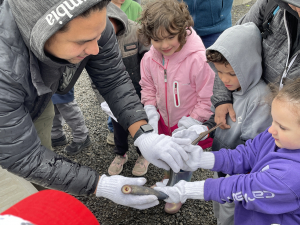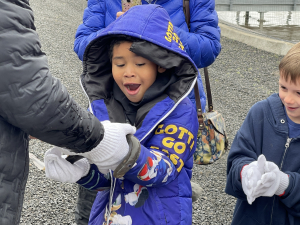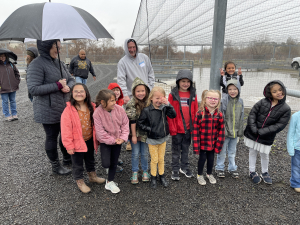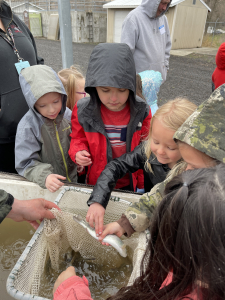Pendleton Early Learning Center Salmon Field Trip
A chilly, rainy morning couldn’t dampen the excitement of kindergartners from the Pendleton Early Learning Center as they enjoyed a field trip to the Pendleton Accumulation Site of the Confederated Tribes of the Umatilla Indian Reservation (CTUIR) Fisheries Program on Wednesday, April 12th.
At the site in Mission, the students got an up close, first-hand look at some fish. They got to touch small Coho salmon and larger Steelhead salmon held in nets in tanks. But the stars of the show were the Pacific lamprey, which are eel-like fish that are anadromous, meaning they migrate from fresh water to the ocean during their life cycle, as salmon do.
The lamprey, held in a large cooler, were handled by Kanim Moses-Conner from the CTUIR Fisheries Program. When he opened the lid and lifted one of the wriggling fish out, squeals erupted from the young students. Moses-Conner pointed out the lamprey’s sucker-like mouth, gills and undulating body, explaining that they are part of an ancient superclass of jawless fish that have been on Earth since before the dinosaurs. After donning gloves, the kindergartners each got a turn to hold the lamprey, much to their delight.
This PELC field trip is part of a learning unit about Salmon or the Núsux Life Cycle, which has been taught by Shawndine Jones, Walk to Language Teacher at the PELC, and Mildred Quaempts, Umatilla Language Master Speaker for CTUIR. The kindergartners receive two or three lessons in the classroom about the salmon life cycle, how important salmon are and learn Umatilla words for types of salmon and where they live: rivers, Columbia River, ocean. Quaempts said the lessons focus on Áwni Tkʷátat, traditional foods like water, salmon, deer, roots and berries. “CTUIR believes that teaching to respect and honor Áwni Tkʷátat will promote a healthy lifestyle. Children must experience learning about Áwni Tkʷátat and stories, so the children will get cultural exposure at school and home,” Quaempts said.
Jones said CTUIR is doing amazing things with the Fisheries Program to help the salmon, and it’s a good experience for the students to see the live salmon on the field trip, which hasn’t occurred since before the COVID pandemic. “The PELC is very thankful for the Confederated Tribes of the Umatilla Indian Reservation Fisheries Program and staff for allowing our students to have this awesome experience,” Jones said.
Judging from the smiles on the small faces of the students, it was indeed an awesome experience!
The PELC thanks those from the CTUIR Fisheries Program who were on site for the field trip: Shaun Montgomery, Aaron Jackson, Ty Minthorn, Kanim Moses-Conner, Paul Sheoships and Jerrid Weaskus and Easton Powaukee.







